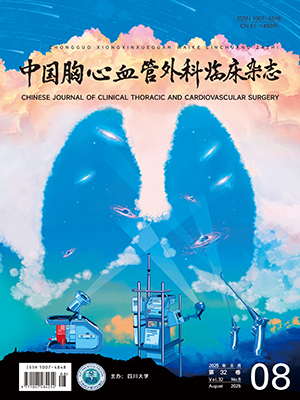| 1. |
Cheng SW, Ting AC, Tsang SH. Epidemiology and outcome of aortic aneurysms in Hong Kong. World J Surg, 2003, 27(2): 241-245.
|
| 2. |
Tsai TT, Trimarchi S, Nienaber CA. Acute aortic dissection: Perspectives from the International Registry of Acute Aortic Dissection (IRAD). Eur J Vasc Endovasc Surg, 2009, 37(2): 149-159.
|
| 3. |
Liu N, Zhang W, Ma W, et al. Risk factors for hypoxemia following surgical repair of acute type A aortic dissection. Interact Cardiovasc Thorac Surg, 2017, 24(2): 251-256.
|
| 4. |
于子翔, 潘旭东, 董松波, 等. 急性A型主动脉夹层孙氏术后低氧血症的相关因素分析. 心肺血管病杂志, 2020, 39(6): 711-715.
|
| 5. |
Sheng W, Yang HQ, Chi YF, et al. Independent risk factors for hypoxemia after surgery for acute aortic dissection. Saudi Med J, 2015, 36(8): 940-946.
|
| 6. |
Shen Y, Liu C, Fang C, et al. Oxygenation impairment after total arch replacement with a stented elephant trunk for type-A dissection. J Thorac Cardiovasc Surg, 2018, 155(6): 2267-2274.
|
| 7. |
Gong M, Wu Z, Xu S, et al. Increased risk for the development of postoperative severe hypoxemia in obese women with acute type A aortic dissection. J Cardiothorac Surg, 2019, 14(1): 81.
|
| 8. |
Bernard GR, Artigas A, Brigham KL, et al. The American-European Consensus Conference on ARDS. Definitions, mechanisms, relevant outcomes, and clinical trial coordination. Am J Respir Crit Care Med, 1994, 149(3 Pt 1): 818-824.
|
| 9. |
王登峰, 张超, 韩冬, 等. Stanford A型急性主动脉夹层孙氏手术后低氧血症危险因素探讨. 心肺血管病杂志, 2021, 40(1): 53-55, 63.
|
| 10. |
郭伟, 郭俊晓, 刘志平. Standford A型急性主动脉夹层术后低氧血症相关危险因素分析. 内蒙古医科大学学报, 2020, 42(3): 229-233, 238.
|
| 11. |
孙舸. StanfordA型夹层术后并发低氧血症的危险因素分析. 大连医科大学, 2013.
|
| 12. |
林丽珠, 梁蓓薇, 梁东科, 等. Stanford A型主动脉夹层术后低氧血症的围手术期危险因素分析. 中国医师进修杂志, 2018, 41(1): 25-29.
|
| 13. |
黄思纳, 欧斌, 张剑彬. StanfordA型主动脉夹层术后重度低氧血症的危险因素分析. 岭南心血管病杂志, 2018, 24(4): 433-436.
|
| 14. |
宋先荣, 程兆云, 韩宇, 等. 急性A型主动脉夹层术后低氧血症的相关因素及对策. 中国心脏大会2014论文汇编, 2014: 306.
|
| 15. |
周楚芝, 王湘, 姜妮, 等. 急性A型主动脉夹层孙氏术后低氧血症的危险因素分析. 岭南心血管病杂志, 2017, 23(2): 165-170.
|
| 16. |
王冀, 张海涛. 术前肾功能不全与主动脉夹层术后低氧血症发生率的关联性研究. 中国临床医生杂志, 2019, 47(1): 30-33.
|
| 17. |
郝智鹏, 王咏, 朱雨, 等. Stanford A型主动脉夹层术后重度低氧血症临床分析. 第三军医大学学报, 2020, 42(9): 929-936.
|
| 18. |
鞠帆, 刘楠, 潘旭东, 等. Stanford A型主动脉夹层术后重度低氧血症风险预测模型的探索. 中华医学杂志, 2016, 96(13): 1001-1006.
|
| 19. |
Wang Y, Xue S, Zhu H. Risk factors for postoperative hypoxemia in patients undergoing Stanford A aortic dissection surgery. J Cardiothorac Surg, 2013, 8: 118.
|
| 20. |
Nakajima T, Kawazoe K, Izumoto H, et al. Risk factors for hypoxemia after surgery for acute type A aortic dissection. Surg Today, 2006, 36(8): 680-685.
|
| 21. |
Zhou J, Pan J, Yu Y, et al. Independent risk factors of hypoxemia in patients after surgery with acute type A aortic dissection. Ann Palliat Med, 2021, 10(7): 7388-7397.
|
| 22. |
Xi X, Chen Y, Ma WG, et al. Is obstructive sleep apnoea associated with hypoxaemia and prolonged ICU stay after type A aortic dissection repair? A retrospective study in Chinese population. BMC Cardiovasc Disord, 2021, 21(1): 421.
|
| 23. |
张欢欢, 杨玉金, 张加乐, 等. 急性主动脉夹层发生低氧血症患者危险因素的Meta分析. 中国现代医学杂志, 2018, 28(19): 67-74.
|
| 24. |
Kordonowy LL, Burg E, Lenox CC, et al. Obesity is associated with neutrophil dysfunction and attenuation of murine acute lung injury. Am J Respir Cell Mol Biol, 2012, 47(1): 120-127.
|
| 25. |
Jo Y, Anzai T, Sugano Y, et al. Early use of beta-blockers attenuates systemic inflammatory response and lung oxygenation impairment after distal type acute aortic dissection. Heart Vessels, 2008, 23(5): 334-340.
|
| 26. |
Merry HE, Phelan P, Doak MR, et al. Role of toll-like receptor-4 in lung ischemia-reperfusion injury. Ann Thorac Surg, 2015, 99(4): 1193-1199.
|
| 27. |
Deng Y, Hou L, Xu Q, et al. Cardiopulmonary bypass induces acute lung injury via the high-mobility group box 1/toll-like receptor 4 pathway. Dis Markers, 2020, 2020: 8854700.
|
| 28. |
Xing Z, Han J, Hao X, et al. Immature monocytes contribute to cardiopulmonary bypass-induced acute lung injury by generating inflammatory descendants. Thorax, 2017, 72(3): 245-255.
|
| 29. |
Lee YL, King MB, Gonzalez RP, et al. Blood transfusion products contain mitochondrial DNA damage-associated molecular patterns: A potential effector of transfusion-related acute lung injury. J Surg Res, 2014, 191(2): 286-289.
|




